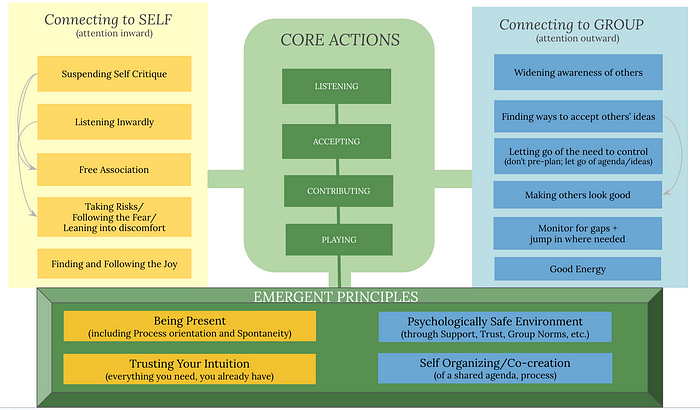How improv can save the world
Okay, that’s a big claim. But I think that if every person on this earth got more in touch with themselves and others, more positive, more creative, more able to deal with ambiguity, we’d have come a long way.
There would still be the objective challenges of economic inequality, climate change, and so on, but if we could freely brainstorm wild solutions to our problems, genuinely listen to each others’ perspectives and learn to express our own, and find ways to love others’ contributions, we’d have a much better shot at finding the answers to our problems, if those answers do exist.
Wait improv? Like, Whose Line Is It Anyway?
Yes and no. Whose Line is definitely the most popular improv show I’ve seen so far, but improv extends far beyond that. It comes from theater warm-up techniques that have been generalized both into its own genre of theater as well as into a set of teaching techniques to teach people its lessons and let them generalize to the rest of their lives.
Research has shown that improv can increase creativity and psychological well-being[1], divergent thinking and uncertainty tolerance[2], as well as writing fluency[3], and more. It is also used in a range of totally non-theater settings from schools to business situations. It also totally changed who I am as a person.
Who am I?
I come from a family that placed a lot of emphasis on improvement. That can be great, but it can also narrow one’s focus. I used to believe that to engage with someone intellectually, one had to find something to disagree about, and then formulate a clear and articulate argument for them to spar with. Some people do enjoy this, but many do not.
As soon as I started learning improv, I immediately fell in love with the way it changed my brain. The only thing that was wrong was to judge your own or others’ contributions as wrong. This little paradox broke open my optimization-machine of a brain, and finally allowed me to practice all of the skills that were pushed to the sidelines while I was perfecting everything else. But what I found was that these skills did not deserve to be on the sidelines; they were crucial abilities for everyone in the modern world.
My academic work has to do with re-thinking what K-12 curriculum could look like for the 21st century. I have also been performing, coaching, and directing improv in Boston for several years. I enjoy thinking about what students should learn — on the one hand, from mathematics, but on the other, from improv comedy.
How do we do this?
Since my career thus far has been focused on synthesizing research into frameworks, I couldn’t help but apply the same methodology to improv. By looking across many research articles, blog posts, and books, as well as triangulating with my personal experience, I came up with the following framework, which attempts to capture all of the elements that go into an improv mindset, and how they relate to each other.

There are two main pieces in the framework: Connection to Self and Connection to the Group. Each of these has important lessons that can each be learned from many different types of exercises and from many different angles in many different contexts.
Running through them all are the four core actions: Listening, Accepting, Contributing, and Playing. Finally, emerging from this mindset are improv principles: being present, trusting your intuition, creating a psychologically safe environment, and self-organization/co-creation.
The actions and principles are too big to be directly practiced, but by practicing the elements of connecting to self and connecting to the group, they get developed as well.
Diving into each element:
If you are not curious about the specifics of this framework, you can skip this section or finish reading here. The following is for people who really want to go into the weeds:
CONNECTION TO SELF:
Listening Inwardly
At any given moment, there are countless feelings, perceptions, and interpretations just under the surface of our awareness. Practicing noticing them leads to a heightened receptivity to one’s own inner workings, and thus inspiration, flexibility, and more grounded/centered responses to inputs.
Free Association
Our brains are wired to process information via networks of associations. When we perceive an input, it is automatically interpreted through our experience, and thus activates everything we associate with that interpretation. Raising awareness of associations can change a creative choice from “how can I come up with an idea?” to “which of the many ideas that I automatically already create should I choose this time?”
Suspending Self Critique
In order to strive to improve, we often reflexively engage in self evaluation so that we may continue our quest for improvement. But this quest presupposes the direction of improvement is known and that any act can be properly evaluated relative to that direction. Thus it can be counterproductive in creative endeavors: creative acts will usually not fit properly into existing schemas and seem “wrong”. Therefore it is important to suspend self judgment in order to not subconsciously reject one’s own ideas before they have had a chance to be explored.
Taking Risks / Following the Fear / Leaning into discomfort
Instinctively, we back away from discomfort, fear, and risks. In fact, that is what those feelings have evolved to do: discourage us from pursuing something further. When engaging in creative acts, however, it is sometimes important to reinterpret those feelings as a sign that something important or interesting lies ahead!
Finding and Following the Joy
We are not used to keeping a sharp eye out for joy. Sometimes good or aesthetically pleasing things happen, and that’s nice. But in creativity, we must hone this sense. Finding joy is a skill. Once it is found, there must be an active process of following it, letting your decisions not only be affected by it but informed or even based on joy. There are many reasons we might choose one option forward over another, and it is unusual to place so much emphasis on joy, but it is the one thing that indicates a path to staying truly connected to oneself. Learning to recognize what one enjoys and what feels right can be a rewarding and useful skill.
CONNECTION TO GROUP
Widening awareness of others
There is often a large emphasis placed on listening. It’s true that it is important to hear what people say in order to react to it. But there is much more to react to than someone’s words, or even more than what they intend for others to react to. In sign language there is a word that means listening with the eyes. Learning to notice people’s body language and small changes and the way they can be interpreted is integral to reacting holistically and truly to the entirety of the other person’s current state and thus the entirety of what they are offering.
Finding Ways to Accept Others’ Ideas
We have by default an immediate reaction to certain things. In trying to react authentically we may sometimes find that our authentic reaction is distaste or disgust, or simply boredom. But that is a choice we are subconsciously making. In fact, we have many possible reactions to any given thing. If we learn to pause and choose a reaction, or at least to notice a reaction that leads us to disengage from the other person, we can choose to find something we like about it and focus on that, or see the options still left or made available by that choice and add something to create an environment that may be better for everyone. Sometimes we even judge the artistic merit of others’ ideas or actions, stepping out of the moment into the meta to do so. There is a saying, “if you’re not having fun, you’re the asshole.” When we find ourselves judging others, realize that they are in the moment and acting authentically to them, and you are the one making a bad decision: so judge yourself and stop doing that, and find a way that is honest to you that will let you re-engage.
Letting go of the need to control
(don’t pre-plan; let go of agenda/ideas)
On many levels, conscious and unconscious, we are planning for the future. In every moment, we have hypotheses of what will happen next, and we’ve already begun planning how we’ll respond. In order to be open to the present, it’s necessary to become aware of and let go of our planning and our plans, and refocus on the other people and what they are currently doing. This applies even at the word level — we often think we know what people are going to say, and it throws us off when they say something else. This will never go away, but the important and trainable aspect is how quickly one can let go of their idea and move on to responding to the current moment.
Making Others Look Good
Instinctively, our thoughts focus around ourselves. If each person in a group takes care of themselves, then everyone will be taken care of. It is generally good to make sure you have the capacity to help others before rushing to help them. However, in a group creating something, it can be more effective if each person takes care of everyone else; if everyone’s attention is on making sure everyone else is having a good time, there is a much higher chance that everyone will have a good time. Instead of one person looking out for you, there are many! This attention and effort must be relatively selfless; it requires an explicit goal of not just making sure everyone is okay, but making everyone around you shine! What are their strengths? What do they need? How can I give a context for their idea that would make that idea even better?
Monitor for Gaps and Jump In When Needed
To contribute constructively to the group, it is important to fight the urge to stand in the background, and instead, monitor everything that’s going on to immediately notice gaps and jump in where you are most needed. If everyone does this, this is when a group becomes more than the sum of its parts, working like a well oiled machine.
Good Energy
This is the least definable aspect of social creative pursuit. It is much simpler to define “bad” energy than “good” energy. On some level, this means making sure that one’s personal worries and baggage do not affect one’s participation with the group. But on other levels, it simply means being positive about whatever happens, even the things that aren’t directly the creative act. Simply being in the room together already creates causal connections to what will be created. Humans are incredibly good at picking up on negative emotions, so it is important to fully commit to the process and the present.
To wrap up, I will leave you with one question:
If everyone in the world had an improv mindset, how much more could we achieve?
[1] Schwenke, D., Dshemuchadse, M., Rasehorn, L., Klarhölter, D., & Scherbaum, S. (2020). Improv to improve: the impact of improvisational theater on creativity, acceptance, and psychological well-being. Journal of Creativity in Mental Health, 1–18.
[2] Felsman, P., Gunawardena, S., & Seifert, C. M. (2020). Improv experience promotes divergent thinking, uncertainty tolerance, and affective well-being. Thinking Skills and Creativity, 35, 100632.
[3] DeMichele, M. (2015). Improv and ink: Increasing individual writing fluency with collaborative improv. International Journal of Education & the Arts, 16(10).
